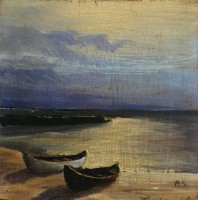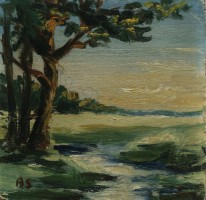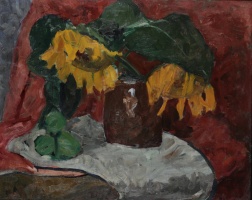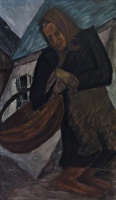
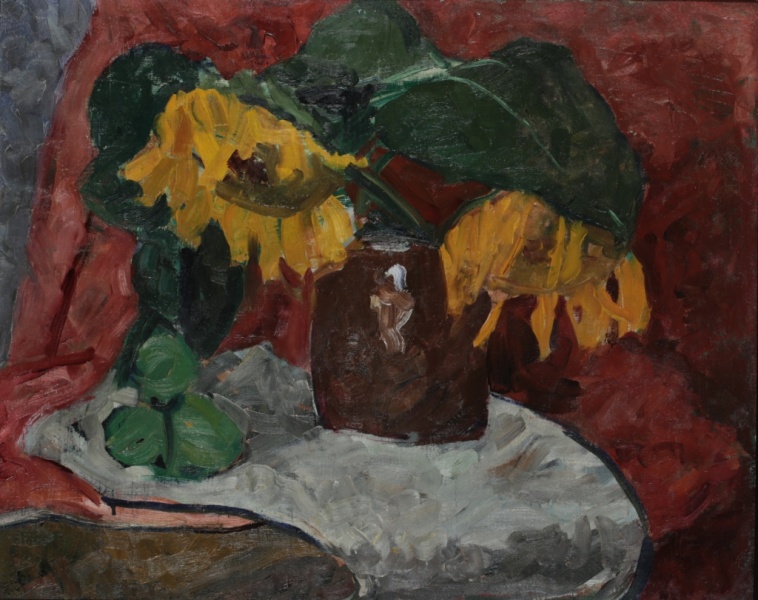

Sunflowers
| Author: |
Antanas Samuolis (1899–1942)  |
| Created: | 1933 |
| Material: | canvas |
| Technique: | oil |
| Dimensions: | 60 × 75 cm |
Although Édouard Manet (1832–1883), one of the pioneers of Impressionism, is considered the originator of sunflower painting in modern art, the world’s most famous sunflowers were painted by Vincent van Gogh (1853–1890). Antanas Samuolis (1899–1942) particularly admired van Gogh, one of the idols of his generation, whose art strongly influenced not only his work but also that of his tragic contemporary Marcė Katiliūtė (1912–1937). The picture Sunflowers is Samuolis’ symbolic and sentimental tribute to the Dutch genius of Modernism. In fact, when van Gogh painted the flowers he was influenced not so much by nature in Provence, but more by French Impressionism. Paul Gauguin (1848–1903) painted sunflowers when he was living in Tahiti, as a reference to van Gogh, his friend who had taken his own life and the successor to Impressionism, and to France, his homeland. Gauguin even had some sunflower seeds sent to him from France, and began to grow the impressive flowers in his Polynesian garden. He painted his Sunflowers in memory and out of sorrow for his friend, who had committed suicide in 1890. On the same theme, the picture Sunflowers by the open-minded Lithuanian artist Vladas Eidukevičius (1891–1941) in the collection of the Lithuanian Art Museum should be mentioned. That picture is one more tribute to van Gogh by Lithuanian artists.
Text author Giedrė Jankevičiūtė
Members of the Ars group tended towards emotionality, Expressionism, and an uneven texture in their work. They turned to folk art, and sought inspiration in nature. A large variety of genres appeared, and in addition to the portraits, landscapes and occasional historical paintings favoured by older artists, they began to create genre compositions, still-lifes and religious paintings. Members of the Ars group sought to develop a unique style in Lithuanian art, in order to combine the traditions of the national cultural heritage and the artistic innovations of Western Modernism. In 1932 and 1934, two exhibitions were held in Kaunas, and at the end of 1932, the Ars manifesto, the only programmatic text in the history of interwar Lithuanian art, was published.
The 1932 exhibition of work by the Ars group, the most prominent Modernist group in Lithuania, featured works made in Kaunas and Paris by the sculptor Juozas Mikėnas, the painters Antanas Gudaitis, Antanas Samuolis and Viktoras Vizgirda, and the graphic artists Vytautas Kazimieras Jonynas, Telesforas Kulakauskas and Jonas Steponavičius. Adomas Galdikas and Mstislav Dobuzhinsky, teachers at Kaunas Art School, also took part in the exhibition, in order to show their support for the young artists.
The event was accompanied by a theoretical statement of artistic principles, soon to become known as the Ars manifesto. It declared:‘Considering the current situation, we are convinced that the absence of deeper explorations in art, and the imitation of worn-out artistic forms, is killing our art. We have resolved to serve the renaissance of our homeland, and to create a style for the new era’ (ARS, Kaunas, 1932). The second Ars exhibition, held in 1934, included the same eight participants, but without Dobuzhinsky. Conservative older artists were indignant that their work was criticised by the Ars group, and themselves asked a question in the press:‘What our folk art has in common with these dumb sculptures, these pieces of canvas soiled with murky-coloured paint, these portraits with bulging eyes, crooked noses and noseless faces, we simply do not know’(‘Art and Pseudo- Primitivism’, Lietuvos aidas, 1932, No 273, p. 5). However, the visual and aesthetic principles mapped out and established by the Ars group probably had the greatest impact on the modernisation of Lithuanian art.
Text authors Dovilė Barcytė and Ieva Burbaitė
Source: Law firm Valiunas Ellex art album OBJECTS ON SHOW (2017). Compiler and author Giedrė Jankevičiūtė, KAUNAS–VILNIUS / 1918–1945 (2021). Compilers and text authors Dovilė Barcytė and Ieva BurbaitėExpositions: "A Glance at the History of Lithuanian Art from Užupis", 30 August 2018 – 1 June 2019, Lithuanian Art Centre TARTLE (Užupio St. 40, Vilnius). Curator Giedrė Jankevičiūtė. "A Woman in Yellow. The Retrospective and Inspirations of Antanas Samuolis (1899–1942) ", 15 February – 08 September 2024, National M. K. Čiurlionis Art Museum, Kaunas. Curators of the exhibition Genovaitė Bartulienė ir Inesa Kuliavaitė-Čepaitienė.







